Somnath mandir
Somnath Mandir: The Home of Shiva
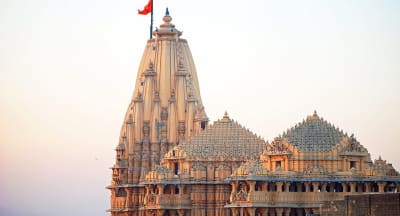
History of Somnath Mandir
Legends trace the temple's beginnings to the mythological era. The Shiva Purana, a revered Hindu scripture, mentions Lord Soma, the Moon God, himself building the first temple here. While historical evidence suggests the existence of a temple dedicated to Shiva at this location as early as the 6th century BCE, the exact details remain shrouded in time.
Somnath's history is marked by periods of immense grandeur followed by devastating destruction. The temple flourished as a prominent pilgrimage site for centuries. Several rulers, including powerful dynasties like the Chalukyas and the Rashtrakutas, contributed to its development and beautification. However, the temple faced its first major challenge in the 11th century. Mahmud of Ghazni, a ruthless Muslim ruler, raided Somnath in 1026. The infamous raid resulted in the plundering of the temple's immense wealth and the destruction of the structure. This event deeply affected Hindus, but it wasn't the end of the story.
Somnath's spirit of resilience shone through. Over the centuries, the temple was rebuilt multiple times, a testament to the unwavering faith of its devotees. The exact number of reconstructions is debated by historians, but each rebuilding stands as a symbol of the enduring spirit of Hinduism. Following the destruction by Mahmud of Ghazni, the temple was rebuilt during the reign of Bhimdev I of the Solanki dynasty. There were further instances of destruction and reconstruction throughout history, with the temple facing attacks from Delhi Sultans and Mughal rulers.
Finally, after India's independence in 1947, the present structure of Somnath Temple was built. Inaugurated in 1951, it stands tall today, a magnificent example of architectural brilliance and a symbol of India's rich heritage. The current temple was constructed using the Māru-Gurjara style of architecture, distinct from the earlier structures.
Significance of Somnath Mandir

Somnath Temple holds great significance for Hindus for multiple reasons. Firstly, it's a revered abode of Lord Shiva, one of the principal deities in Hinduism. Devotees believe that a visit (darshan) here brings blessings, removes obstacles, and fulfills wishes. Many Hindus consider visiting Somnath, especially during auspicious occasions like Shivratri, to be a pilgrimage of great importance.
What truly elevates Somnath's stature is its designation as one of the twelve revered Jyotirlinga shrines dedicated to Lord Shiva across India. Jyotirlingas are considered to be the most sacred abodes of Shiva, each representing a celestial light column. Somnath holds the distinction of being the "first Jyotirlinga," believed to be the very place where the unending pillar of light emerged from Lord Shiva himself. This association with the origin story of Jyotirlingas imbues Somnath with immense spiritual power and significance.
But the significance goes beyond religious belief. Somnath Temple is often referred to as the "Eternal Shrine" due to its long and storied history. Imagine a temple that has been destroyed and rebuilt multiple times, standing tall as a testament to the unwavering faith of its devotees. Each reconstruction throughout history signifies the enduring spirit of Hinduism and the importance of preserving its traditions. Somnath serves as a powerful symbol of resilience, reminding us that even in the face of adversity, faith can prevail.
Somnath's significance is further amplified by its location on the coast of Gujarat. The temple complex stands proudly facing the Arabian Sea, creating a visually stunning and spiritually uplifting experience. Devotees believe that the sight and sound of the ocean add to the temple's sanctity. Additionally, the temple is situated near the confluence of three rivers – Kapila, Hiran, and Saraswati. Taking a dip in these holy waters is considered particularly auspicious, further enriching the pilgrimage experience.
Architecture of Somnath
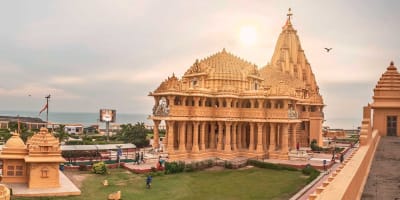
The temple is built in Māru-Gurjara style, also known as the Chaulukya or Solanki style. This distinct Gujarati style is characterized by intricate carvings, towering shikharas (spires), and a strong emphasis on verticality. The temple itself is a magnificent seven-story structure built from red sandstone. The exterior walls are adorned with intricate carvings depicting scenes from Hindu mythology and geometric patterns, showcasing the immense skill of the builders. The main entrance features elaborately carved pillars and decorative arches, welcoming visitors into the temple complex.
Step inside, and the towering shikhara dominates your view. This cone-shaped spire, a hallmark of Māru-Gurjara architecture, stretches majestically skyward. Decorative bands and small ornamental structures called amalakas adorn the shikhara, adding to its grandeur. But the beauty extends beyond the spire. The temple complex encompasses a Sabha Mandap (assembly hall) with intricately carved pillars and a Nrityamandapa (dance hall) boasting beautiful sculptures. These halls provided spaces for gatherings, rituals, and artistic performances, adding to the vibrancy of the temple.
The design also incorporates elements that create a serene and spiritually uplifting atmosphere. Natural light streams through strategically placed windows, illuminating the inner sanctum where the revered Jyotirlinga resides. The entire complex is built on a raised platform, offering a sense of elevation and separation from the everyday world.
Finally, the temple's location on the coast of Gujarat, facing the Arabian Sea, adds another layer of significance. The sight of the majestic structure bathed in sunlight, with the vast ocean stretching out before it, creates a breathtaking visual experience. This unique setting further enhances the architectural beauty and spiritual significance of Somnath Temple.
Temple Timings and Other Details
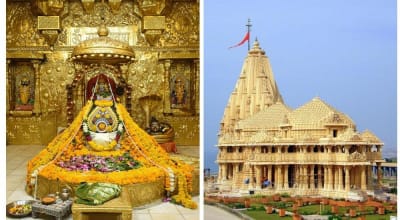
Official Website of Temple - https://somnath.org/
- Darshan Timings: 6:00 AM to 10:00 PM.
- Aarti Timings: Morning = 7:00 AM, 12:00 Noon, 7:00 PM.
- Light And Sound Show Timing: 8:00 PM To 9:00 PM. (Except in the Monsoon / Rainy Season)
Location of Somnath Mandir
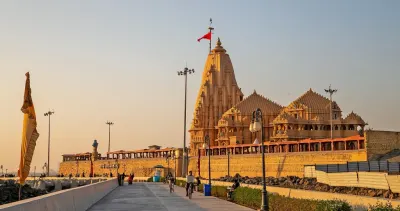
Somnath Mandir is located in the Prabhas Kshetra near Veraval in the Junagadh district of Gujarat, India. The temple stands along the shores of the Arabian Sea, offering a picturesque setting for worship and contemplation. Here's the Google Link for the exact location - Click Here
How to Reach Somnath Mandir
Reaching Somnath Mandir is convenient, with multiple transportation options available:
- By Air: The nearest airport is Diu Airport (DIU), located around 85 kilometers from Somnath. Taxis and buses connect the airport to the temple town.
- By Train: Veraval railway station offers good connectivity to major Indian cities. From the station, taxis, rickshaws, or auto-rickshaws can take you to Somnath Mandir.
- By Road: Somnath is well-connected by road to major Gujarat cities and other parts of India. State-run and private buses ply routes to Somnath from various locations.
Distances from Major Cities:
- Ahmedabad: Approximately 400 kilometers (around a 7-hour drive)
- Rajkot: Roughly 200 kilometers (around a 4-hour drive)
- Mumbai: Approximately 850 kilometers (around a 15-hour drive)
Pro Tip: During peak season and festivals, booking accommodation and transportation in advance is highly recommended.
Nearby Tourist Attractions
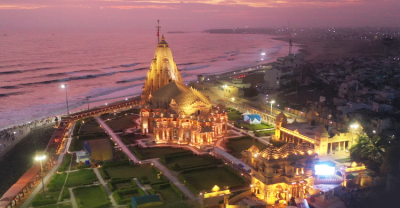
- Prabhas Patan Museum: Located near Somnath Mandir, this museum houses a rich collection of artifacts, sculptures, and historical items showcasing the heritage of the region.
- Somnath Beach: Just a short distance from the temple, Somnath Beach offers stunning views of the Arabian Sea, making it an ideal spot for relaxation and leisurely walks along the shore.
- Junagadh: A historic city near Somnath, Junagadh is known for its ancient forts, palaces, and archaeological sites.
- Diu: A scenic island located nearby, Diu is famous for its beaches, Portuguese architecture, and vibrant culture.
- Gir National Park: Wildlife enthusiasts can embark on a safari to Gir National Park, renowned for its population of Asiatic lions.
A Lasting Legacy: The Enduring Spirit of Somnath Mandir
Somnath Mandir is more than just a place of worship; it's a symbol of resilience, faith, and cultural heritage. Its enduring spirit, evident in its history of destruction and reconstruction, inspires devotees and history buffs alike. A visit to Somnath Mandir offers a chance to experience the rich tapestry of Hinduism, marvel at architectural brilliance, and embark on a spiritual journey. So, plan your trip, embrace the experience with an open mind, and discover the magic of Somnath Mandir, the "Eternal Shrine."




